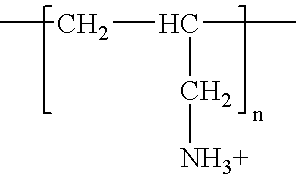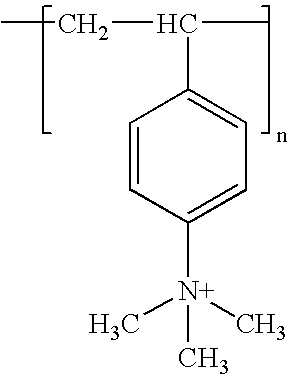Biomedical devices having improved surface characteristics
a biomedical device and surface treatment technology, applied in the direction of instruments, spectacles/goggles, coatings, etc., can solve the problems of imposing the cost of drying equipment, adding time to the overall lens production process, and requiring significant equipment investment, so as to reduce the effect of reducing the complexity of the ophthalmic lens production process and excellent oxygen permeability
- Summary
- Abstract
- Description
- Claims
- Application Information
AI Technical Summary
Benefits of technology
Problems solved by technology
Method used
Image
Examples
example 4
[0156]A lens prepared in accordance with Example 1 is surface treated with a layer-by-layer (LBL) process to increase the hydrophilicity in accordance with the procedures outlined in Example 2, with the following exception: the application and rinsing solution pH for the PAA solution was 2.5, as opposed to 4.5 in Example 2.
[0157]The average (n=4) contact angle was 65. Results are reported in Tables A and B.
example 5
[0158]Coated lenses as treated in Example 4 were treated by dropwise addition of 2 ml of CaCl2 solution. The lenses were dried with mild air.
[0159]The average (n=4) contact angle was 76. Results are reported in Table B.
example 6
[0160]A lens prepared in accordance with Example 1 is surface treated with a layer-by-layer (LBL) process to increase the hydrophilicity.
[0161]A dilute (10−2 molar) aqueous stock solution of poly(ethyleneimine) (50-60,000 MWn from PolyScience) [PEI] was prepared by adding 2.00 grams of PAH to 1400 ml of deionized water. The pH was adjusted to about 2.5 by dropwise addition of hydrochloric acid.
[0162]A dilute PAA solution was prepared as in Example 2. The pH was adjusted to about 2.5 by dropwise addition of hydrochloric acid.
[0163]For example, a Material D macromer may be prepared by reacting isophorone diisocyanate, 2-hydroxyethyl (meth)acrylate and a poly(dialkylsiloxane) dialkoxyalkanol in the presence of a catalyst.
III. Biomedical Products
[0164]In addition to the coated ophthalmic lenses described herein above, the present invention may be applied in alternative ways in a biomedical (e.g., ophthalmic lens) manufacturing environment. For example, one or more polyionic materials ma...
PUM
| Property | Measurement | Unit |
|---|---|---|
| pH | aaaaa | aaaaa |
| temperature | aaaaa | aaaaa |
| temperature | aaaaa | aaaaa |
Abstract
Description
Claims
Application Information
 Login to View More
Login to View More - R&D
- Intellectual Property
- Life Sciences
- Materials
- Tech Scout
- Unparalleled Data Quality
- Higher Quality Content
- 60% Fewer Hallucinations
Browse by: Latest US Patents, China's latest patents, Technical Efficacy Thesaurus, Application Domain, Technology Topic, Popular Technical Reports.
© 2025 PatSnap. All rights reserved.Legal|Privacy policy|Modern Slavery Act Transparency Statement|Sitemap|About US| Contact US: help@patsnap.com



